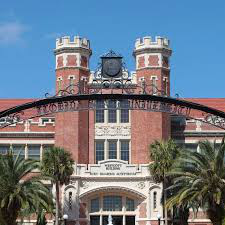Conveners
Nuclear Structure: Parallel 4
- Kevin Fossez
The Quark–Meson–Coupling (QMC) model self-consistently relates the dynamics of the internal quark structure of a hadron to the relativistic mean fields arising in nuclear matter. The QMC energy density functional (EDF) was successfully employed to investigate several ground state properties of even-even finite nuclei across the nuclear chart. In this presentation, the latest developments in...
Systems of few interacting neutrons have long fascinated nuclear physicists,
with ample of theoretical and experimental activity throughout the decades.
Interest in these systems has recently surged in light of new indications that
few-body resonances comprised of neutrons may exist in nature. In this talk, I
will present studies of few-neutron systems based on pionless effective...
A realistic description of atomic nuclei, in particular light nuclei characterized by clustering and low-lying breakup thresholds, requires a proper treatment of continuum effects. We have developed an approach, the No-Core Shell Model with Continuum (NCSMC) [1,2], capable of describing both bound and unbound states in light nuclei in a unified way. With chiral two- and three-nucleon...
We demonstrate that paradigm shift from considering deuteron as a system of bound proton
and neutron to considering it as a pseudo-vector system in which we observe proton and neutron, results in a possibility of probing a new "incomplete" P-state structure on the light-front (LF), at extremely large internal momenta, which can be achieved at high energy transfer electro-disintegration of...
First proposed by Nobel laureate Weinberg in the early 1990s, the so-called Weinberg chiral nuclear force has become the de facto standard for ab initio nuclear structure and reaction studies. However, unlike atomic physics and chemistry, the application of relativistic ab initio methods in nuclear physics is just emerging. An important factor hindering their development is the lack of modern...
Exact solutions for energy eigenvalues and eigenstates for transitional nuclei in the spd-interacting boson model are found by using an infinite dimensional algebraic method. It has been shown that the spd-IBA is a quite powerful model for analyzing nuclear structures. In this lecture, we have studied the GDRs within an extended pairing model with a focus on spectral statistics. The effect of...
Electroweak processes in few-body systems are relevant to nuclear
astrophysics, searches for physics beyond the standard model and
provide additional insight into the nuclear Hamiltonian. Specifically,
effective field theories have opened avenues to provide quantitative
statements for theoretical calculations. Muon capture on the deuteron
is one process that is anticipated to provide...

